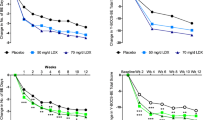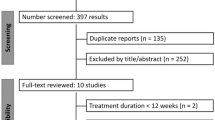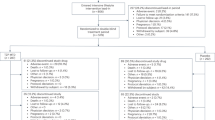Abstract
Background
Weight regain is a major limitation to successful weight maintenance following weight loss. Observational studies suggest that stimulation of dopamine receptors in the central nervous system is associated with weight loss and inhibition of weight gain. Our objective was to test the hypothesis that dopamine agonist treatment would prevent weight regain following acute weight loss in individuals with obesity.
Methods
We conducted a 2-year double blind randomised controlled trial comparing the effect of a dopamine agonist, cabergoline, with placebo on weight regain in obese individuals who had lost at least 5% of their body weight using an 800 kcal/day commercial meal replacement programme. The primary outcome measure was the difference in mean weight between the treatment and control groups over the 2-year period following randomisation.
Results
At 24 months, there was no difference in body weight between cabergoline and placebo treatment after adjustment for age, gender and baseline values (0.6 kg (95% CI: −1.5, 2.6), p = 0.58). The mean (±SD) baseline body weight of the randomised participants was 101.8 kg, the mean (±SD) weight loss with the 800 kcal/day diet was 7.1 ± 1.8 kg and the mean (±SD) weight regain at 24 months was 5.1 ± 7.5 kg. There were no significant differences in BMI, percent weight loss, waist circumference, resting energy expenditure, blood pressure or metabolic parameters at 24 months between the two groups.
Conclusions
Treatment with the dopamine agonist cabergoline does not prevent weight regain in obese individuals following weight loss.
This is a preview of subscription content, access via your institution
Access options
Subscribe to this journal
Receive 12 print issues and online access
$259.00 per year
only $21.58 per issue
Buy this article
- Purchase on Springer Link
- Instant access to full article PDF
Prices may be subject to local taxes which are calculated during checkout


Similar content being viewed by others
References
Ng M, Fleming T, Robinson M, Thomson B, Graetz N, Margono C et al. Global, regional, and national prevalence of overweight and obesity in children and adults during 1980-2013: a systematic analysis for the Global Burden of Disease Study 2013. Lancet. 2014;384:766–81.
Swinburn BA, Sacks G, Hall KD, McPherson K, Finegood DT, Moodie ML et al. The global obesity pandemic: shaped by global drivers and local environments. Lancet. 2011;378:804–14.
Lean M, Hankey C. Keeping it off: the challenge of weight-loss maintenance. Lancet Diabetes Endocrinol. 2018. https://doi.org/10.1016/SS2213-8587(17)30405-9.
MacLean PS, Higgins JA, Giles ED, Sherk VD, Jackman MR. The role for adipose tissue in weight regain after weight loss. Obes Rev. 2015;16(Suppl 1):45–54.
Yu YH, Vasselli JR, Zhang Y, Mechanick JI, Korner J, Peterli R. Metabolic vs. hedonic obesity: a conceptual distinction and its clinical implications. Obes Rev. 2015;16:234–47.
Small DM, Jones-Gotman M, Dagher A. Feeding-induced dopamine release in dorsal striatum correlates with meal pleasantness ratings in healthy human volunteers. Neuroimage. 2003;19:1709–15.
Thompson J, Thomas N, Singleton A, Piggott M, Lloyd S, Perry EK et al. D2 dopamine receptor gene (DRD2) Taq1 A polymorphism: reduced dopamine D2 receptor binding in the human striatum associated with the A1 allele. Pharmacogenetics. 1997;7:479–84.
Munafo MR, Timpson NJ, David SP, Ebrahim S, Lawlor DA. Association of the DRD2 gene Taq1A polymorphism and smoking behavior: a meta-analysis and new data. Nicotine Tob Res. 2009;11:64–76.
Comings DE, Flanagan SD, Dietz G, Muhleman D, Knell E, Gysin R. The dopamine D2 receptor (DRD2) as a major gene in obesity and height. Biochem Med Metab Biol. 1993;50:176–85.
Stice E, Spoor S, Bohon C, Small DM. Relation between obesity and blunted striatal response to food is moderated by TaqIA A1 allele. Science. 2008;322:449–52.
Benton D, Young HA. A meta-analysis of the relationship between brain dopamine receptors and obesity: a matter of changes in behavior rather than food addiction? Int J Obes. 2016;40(Suppl 1):S12–21.
Wang GJ, Volkow ND, Logan J, Pappas NR, Wong CT, Zhu W et al. Brain dopamine and obesity. Lancet. 2001;357:354–7.
Lencz T, Robinson DG, Napolitano B, Sevy S, Kane JM, Goldman D et al. DRD2 promoter region variation predicts antipsychotic-induced weight gain in first episode schizophrenia. Pharmacogenet Genomics. 2010;20:569–72.
Davis LM, Michaelides M, Cheskin LJ, Moran TH, Aja S, Watkins PA et al. Bromocriptine administration reduces hyperphagia and adiposity and differentially affects dopamine D2 receptor and transporter binding in leptin-receptor-deficient Zucker rats and rats with diet-induced obesity. Neuroendocrinology. 2009;89:152–62.
Blum K, Thanos PK, Gold MS. Dopamine and glucose, obesity, and reward deficiency syndrome. Front Psychol. 2014;5:919.
Kravitz AV, O’Neal TJ, Friend DM. Do dopaminergic impairments underlie physical inactivity in people with obesity? Front Human Neurosci. 2016;10:514.
Beeler JA, Faust RP, Turkson S, Ye H, Zhuang X. Low dopamine D2 receptor increases vulnerability to obesity via reduced physical activity, not increased appetitive motivation. Biol Psychiatry. 2016;79:887–97.
Schindler CW, Carmona GN. Effects of dopamine agonists and antagonists on locomotor activity in male and female rats. Pharmacol Biochem Behav. 2002;72:857–63.
Korner J, Lo J, Freda PU, Wardlaw SL. Treatment with cabergoline is associated with weight loss in patients with hyperprolactinemia. Obes Res. 2003;11:311–2.
Gibson CD, Karmally W, McMahon DJ, Wardlaw SL, Korner J. Randomized pilot study of cabergoline, a dopamine receptor agonist: effects on body weight and glucose tolerance in obese adults. Diabetes Obes Metab. 2012;14:335–40.
Manning PJ, Sutherland WH, Williams SM, Walker RJ, Berry EA, De Jong SA et al. The effect of lipoic acid and vitamin E therapies in individuals with the metabolic syndrome. Nutr Metab Cardiovasc Dis. 2013;23:543–9.
Manning PJ, Sutherland WH, Walker RJ, Williams SM, De Jong SA, Ryalls AR et al. Effect of high-dose vitamin E on insulin resistance and associated parameters in overweight subjects. Diabetes Care. 2004;27:2166–71.
Doknic M, Pekic S, Zarkovic M, Medic-Stojanoska M, Dieguez C, Casanueva F et al. Dopaminergic tone and obesity: an insight from prolactinomas treated with bromocriptine. Eur J Endocrinol. 2002;147:77–84.
Delgrange E, Donckier J, Maiter D. Hyperprolactinaemia as a reversible cause of weight gain in male patients? Clin Endocrinol. 1999;50:271.
Cincotta AH, Meier AH. Bromocriptine (Ergoset) reduces body weight and improves glucose tolerance in obese subjects. Diabetes Care. 1996;19:667–70.
Wasada T, Kawahara R, Iwamoto Y. Lack of evidence for bromocriptine effect on glucose tolerance, insulin resistance, and body fat stores in obese type 2 diabetic patients. Diabetes Care. 2000;23:1039–40.
Pijl H, Ohashi S, Matsuda M, Miyazaki Y, Mahankali A, Kumar V et al. Bromocriptine: a novel approach to the treatment of type 2 diabetes. Diabetes Care. 2000;23:1154–61.
Cameron JD, Chaput JP, Sjodin AM, Goldfield GS. Brain on Fire: Incentive Salience, Hedonic Hotspots, Dopamine, Obesity and Other Hunger Games. Annu Rev Nutr 2017; 37:183–205.
Volkow ND, Wang GJ, Tomasi D, Baler RD. The addictive dimensionality of obesity. Biol Psychiatry 2013; 73(9):811–8.
Smith SR, Weissman NJ, Anderson CM, Sanchez M, Chuang E, Stubbe S et al. Mulicentrer, placebocontrolled trial of lorcaserin for weight management. The New England journal of medicine 2010; 363: 245–56.
Pi-Sunyer FX, Aronne LJ, Hesmati HM, Devin J, Rosenstock J, Group RIO-NAS. Effect of rimonabant, a cannabinoid -1 receptor blocker, on weight and cardiometabolic risk factors in overweight or obese patients: RIO-North America: a randomized controlled trial. Jama 2006; 295: 761–75.
Acknowledgements
This study was supported by a research grant (11/188) from the Health Research Council of New Zealand. The authors are particularly grateful to the participants who took part in the study and to Anne Ryalls, Liz Berry, Gavin Hendry, Angie Anderson and Mandy-Phipps-Green for their assistance with the conduct of this study.
Author information
Authors and Affiliations
Corresponding author
Ethics declarations
Conflict of interest
The authors declare that they have no conflict of interest.
Rights and permissions
About this article
Cite this article
Manning, P.J., Grattan, D., Merriman, T. et al. Pharmaceutical interventions for weight-loss maintenance: no effect from cabergoline. Int J Obes 42, 1871–1879 (2018). https://doi.org/10.1038/s41366-018-0165-3
Received:
Revised:
Accepted:
Published:
Issue Date:
DOI: https://doi.org/10.1038/s41366-018-0165-3



